Porcelain Insulator News
by Jack H. Tod
Reprinted from "INSULATORS - Crown Jewels of the Wire", April 1976, page 16
Dear Jack:
Per your request, I've enclosed a shadow profile and the measured dimensions
of my U-975 threadless porcelain. It is a medium brown color, and note the
annular groove about 2/3 the way up in the very large pin hole. The insulator
appears to have been "turned" but is quite uneven in spots.
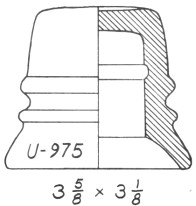
As far as background, I have little to tell you. It came from Lachute,
Quebec, which is about six miles from my place as the crow flies. This insulator
came from the estate of a doctor who was 94 when he died two years ago. He had
been an antique collector all his life as had his father, also a doctor, before
him.
In settling the estate, the good antiques were taken to Montreal to be
auctioned by a high class auctioneer, after which a picker was allowed in to
salvage what was left. The insulator was given to him as being of no value! He
held it a year before he told me about it last May. He knew by then it had some
value so I didn't get it for nothing.
I am trying to obtain some information about the old telegraph lines in that
area, as well as information about early pottery works. If I get any pertinent
facts I will certainly let you know.
Doug Henderson
(Hawkesbury, Ont.)
- - - - - - - - -
Dear Doug :
Many thanks. Perfect drawing data. Interesting background info. The very
large "pin hole" and groove in same makes me think there could be a
connection here with one or more of the early Varley patents. (See Nov 1974 CJ,
page 17 for a Varley item.) Gerald and I looked up and studied the six Varley
patents (all Ca. 1868) once, and this U-975 does seem to fit in there somewhere,
most probably the patent #76,358 of April 7, 1868.
Jack

George Lahm (Calicoon, N.Y.) has a small Fred M. Locke which approximates the
U-330 style but which is really quite different. See photos at right and drawing
of it below. It has the Locke marking #0-3 on the crown.
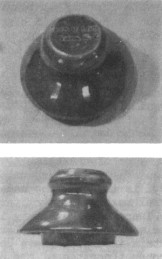
Several New York collectors have the U-330, and I've seen at least one there
in person -- but can't recall if it was like the U-330 chart drawing or more like
George's specimen. Maybe you N.Y. fellows will write to let us know which. If
they are in agreement with the U-330 chart drawing, we'll make this one U-330A.
If like George's, we'll consider revising the U-330 drawing now in the chart.
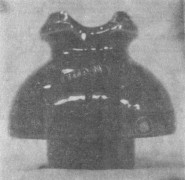
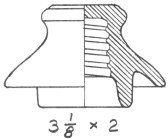
Pictured at the left is a U-648 in George's collection, and note the very
clear LIMA, N.Y. marking. This marking is now in most of the larger collections
on multiparts but is still very TUF on uniparts.
Dear Jack:
... Also, what can you tell me about the "Bennington ware"
insulator? Is there a sure way to tell the color and style?
Arthur E. Jones,
Newcastle, Maine
(plus others occasionally)
- - - - - - - - -
Dear Arthur:
Well, I guess the surest way to tell the color and style is to trot down to
Ohio where Jerry Turner can take you down to the bank vault and show you the
only known specimen of an insulator made of the proverbial "Bennington
ware". This is the U-982 threadless, and I guarantee you will enter a state
of euphoria if you ever hold this beautiful and unique specimen in your hands.

This insulator was located a few years ago by Forrest Jones (New Carlisle,
Ohio), and he had documentation on its museum origin dating back to 1917 as I
recall. I was convinced by the documentation that it was indeed made by
Bennington in Vermont.
There is also documentation, via old woodcuts of trade fairs in the 1850's
that Bennington produced threadless pin types of the Elliott types (U-979, 980,
981), but these are of regular white (flint type) porcelain. The U-982 is the
only one made of "Bennington ware" in the normal meaning of that term.
There have been many instances in antique stores, flea markets, and even
large insulator shows (!) where certain insulators have been labeled
"Bennington", either through ignorance of the subject or with some
slight fraud in mind. In most instances, these are the pretty mottled browns
made by Pittsburg, circa 1910- 1920 and obviously of the threaded styles. If you
ever encounter any such thing, I suggest you don't argue the point, Just turn
around and walk in the other direction. But if you ever do encounter another U-982 with a pretty, speckled, rich brown glaze, don't argue the point -- just
buy it, quickly.
Jack
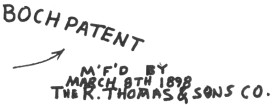
Paul Mohrs (Indiana) recently acquired a brown U-928 with the regular BOCH
marking fouled up more than any other reported thus far. Not only is the top
line flying off in the distance, but note the patent date line is misplaced down
to the third row of type. All further evidence that this was a makeshift
handstamp made from loose rows of linotype slugs held together in the crudest
fashion.
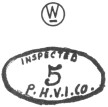
Paul also has a massive bushing (4-5/8 dia., 18", long) with the
Westinghouse marking, but also with the P.H.V.I. marking. This is unusual in
that any marking indicating Pittsburg High Voltage Insulator Co. is a rarity on
insulators of any type. (Westinghouse was initially the selling agent for PHVI
and completely owned that company by 1922.)
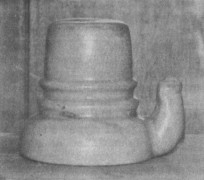
Jon Mcintire and John Whitmore (both Harrisonburg, Va.) recently made another
of those buy-of-the-year flea market finds and ended up with a nice porcelain
"Tea Pot". (This is another Civil War threadless type.)
Jon sent this excellent photo of it and also a shadow profile and measured
dimensions which allowed us to make the drawing of it for the Universal Style
Chart. It will be U-990, and the comparable glass item is CD-790 in Woodward's
Consolidated Design Chart.
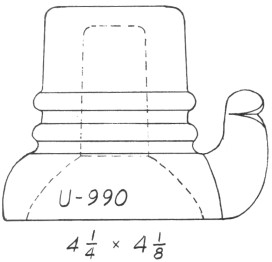
Jon says this specimen is a tannish color with lightly mottled blue-gray all
over. It has a definite incised feature on the crown, but it can't be determined
if this is an intended marking or just some sort of a blemish. We would like
others to report if their "Tea Pot" specimens have any similar crown
marking so we will know one way or another on this.
Jon, John & I are at a bit of a loss to explain just how this insulator
was fired as there is no obvious "prepared firing surface". There are
several very small bumps on the base and a dimple in the pin hole top which may
have a connection with the firing method.
This U-990 is another of the Confederate classics wherein the Teapot spout
and the various slashes in the other styles (U-988 etc.) afforded quick means
for putting up lines by stringing wires, slack fashion, over the insulators from
pole to pole. Each insulator style has some form of grooves or notches, or both,
to afford a means of captivating the slack wire conductor with a tie wire when
there was time to do this. This is not inconsistent with modern or even current
military methods where it is important to be able to string combat lines in
rapid and easy fashion.

Walt Lehnert (Minneapolis) recently acquired a 1915 catalog of Electro
Importing Company along with a bunch of "radio junque", and this
positively identified the EICO marking as seen on radio antenna strain
insulators. It pictured the porcelain strain with the spiral fins as shown above
right.

The very unusual porcelain radio antenna "ball type" strain with
petticoats was also identified as an Electro item. (See page 165 of Gerald
Brown's 2nd Edition.)
Lastly, the catalog pictured the Electrose (composition) ball type of radio
antenna strain with the raised radial fins.

Walt has also come up with an ordinary type radio strain with a Diamond-P
marking, presently unattributed. I'm sure Walt's detective work will decode this
marking in due time.
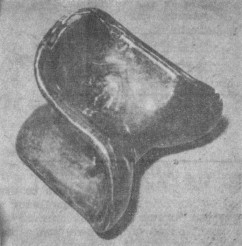
Dear Jack:
I bought this insulator from a little antique shop in Lincoln, Nebraska.
It's a beautiful mottled rich brown, and the enclosed photo doesn't do it
justice. It's about 5" long in the longest directions.
I've taken it to two shows and no one there had seen one like it. Needless to
say, I could have sold it. I would be proud if you could print this picture of
it in Crown Jewels. I have 1128 insulators in my collection, some beauties in
porcelain and glass too. Would appreciate anything you can tell me about this
one.
Margaret McDermott
(Lena, Ill. )
- - - - - - - - -
Dear Margaret:
This is a form of "link strain" insulator, used for dead-ending and
other applications where there is a high voltage potential between the opposing
links connecting to the insulator. Similar insulators were first cataloged by
The Ohio Brass Co. in 1909 and were later nicknamed in the O-B catalogs as
"pork liver" insulators. A very early version of these O-B link
strains is crude and very rare, only several known, but the more modern version
is rather commonly available in collector circles.
I would judge your specimen may be an even earlier version of this insulator
type. It certainly is a highly unusual one. No wonder others drool over you
having it. It is difficult to place valuations on these unusual early classics,
but I'm sure many collectors would pay a pretty penny to get this one.
Jack
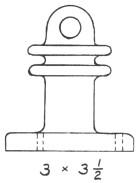
Dear Jack:
Am sending an oddball insulator that I recently picked up at a flea market.
Cleaned off about 3 layers of paint but couldn't find a marking. Would
appreciate any information you might have on its use.
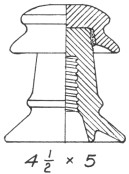
Also found at one of our hydro plants one mint porcelain pin type that is
quite similar to the UET 87 on page 20 of Gerald Brown's Second Edition. The
crown is flatter and the skirts more rounded on the top surfaces. No markings
that I could find. It's a two-piece, the crown and top skirt part being cemented
to the bottom skirt and middle stem.
Walter Lehnert
(Minneapolis)
- - - - - - - - -
Dear Walt:
Re your first item, someone once stole the end support from the towel rack in
my bathroom (also painted three times), and I was wondering what happened to it.
Just kidding; it looks like a form of standoff, possibly for use in neon signs.
Re your second item, this is a telephone transposition pin type cataloged by
Thomas in 1912. The earlier but similar version (Brown's 2nd Edition, per the
specimen in Dora Harned collection) was shown in 1904 & 1907 catalogs, It
brought tears to my eyes to have to leave this out of the style chart, since it
is a 2-piece cemented multipart and not a "unipart" by our arbitrary
definition. It's a rare and valuable item. This classic tramp really turns on
anyone specializing in tramps, but the two or three known specimens just won't
go around for everybody.
Incidentally, Canadian Porcelain Co. also cataloged a multipart tramp, circa
1912-1916. Thus far, I've never had anyone report having one of them.
Jack

Dennis McHenry (Iowa), secretary of the National Insulator Association,
was bugged by the N.A.T.Co. marking on both glass and porcelain
insulators still being in the mystery class, so he set out to identify the
marking. After some persistent research, he determined without any doubt the
marking is for North American Telegraph Company, The very interesting account of
Dennis' research work is written up in the January issue of Drip Points, the
N.I.A. quarterly newsletter and official organ.
All collectors should join me in thanking Dennis for his work an this. Our
list of mystery markings on insulators continues to shrink because of this kind
of dogged research by so many interested collectors.
No matter how vigorously I pursue a policy of checking back with reader
reporters when anything looks improbable, implausible or impossible, I still
have a normal percentage of goofs. Here's the latest one.
Note the U-169 animal on top of page 40 of the Feb 1976 issue. It now turns
out this specimen has a metal pin hole thimble, so you can take back most (not
all) of what I said about it there. Next question is, does anybody else have one
of these haystacks with a metal thimble, and can you send any details of the
actual pin hole configuration and the full marking on the thimble??
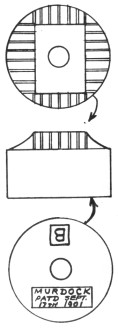
Wendell Hunter (DuBois, Pa.) has this porcelain knob which originally came
from an iron foundry originating around the turn of the century. It's
2-1/4" diameter, and both halves alike.
The MURDOCK markings on it indicate patent 682,831 of Sept 17, 1901, Henry D.
Murdock Pittsburg, Pa. I've sketched below (from the patent) how these were to
be used. The idea was that the knobs had different size grooves in each side,
and varying wire sizes could be accommodated by rotating the knobs to a certain
position. (What a lousy arrangement, and I'll bet anyone trying to install these
soon just gave up in disgust!
The "B" marking on it indicates the smaller size cataloged. Size
"A" was the larger size. See photo on page 43 of the 1902 C. S.
Knowles catalog (Reprint, Frank Peters Books, $3, see CJ ads.)
The name may also involve William J. Murdock Co., Chelsea, Mass., established
1896, a manufacturer of radio equipment and phone receivers by 1920. By 1920's
the various "Murdock" porcelain power insulators were being jobbed by
J. H. Parker & Son in Chelsea.
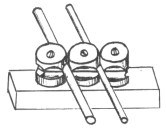
Wendell also found a 2-wire Grouse-Hinds conduit end outlet bushing with this
new marking for us (left), a monogram C. H. Co.

Additionally, Wendell advises that the formerly unattributed R-H & Go.
marking is that of Reyburn-Hunter & Co., Pittsburgh, a manufacturer of
lightning rod systems and equipment. He has a booklet, circa 1900's, issued by
this company, and known specimens with the R-H & Co. marking are lightning
rod insulators.
Ed & Judy Gish (Houston) report another great find in early classics, and
will it never cease! This time it's a Fred Locke "Combination
Insulator", as he called them (porcelain top disk with spouts, glass
bottom), and the porcelain top shell on this is WHITE glaze!! I can't recall
anyone ever having told me of one of these in white. We'll try to get a
black-white photo for the next issue.
The top porcelain shell has the #4-1 Fred Locke marking. The aqua glass base
is embossed LOCKES PAT'S DEC. 15 - 96 JUNE 7 98.

We've reported this knob before, but it's time for a repeat when more queries
arrive on it twice monthly and when they start coming by insured parcel
post with dollar bills for return costs!
This is a standard electric fence knob sold by Wisconsin Porcelain Co. They
are a very common knob and can easily be found in junk boxes at flea markets.
The threaded hole is to accommodate a nail-type insert for use on wooden
posts. They also come with a metal cap at base which captivates wire pigtails
for use on the regular steel fence posts. (For more details, see page 24, Dec
174 CJ, & Gerald Brown's 2nd Ed., page 163.)
| 